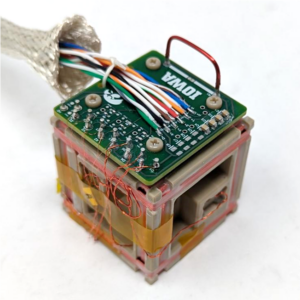New Magnetometer Technologies
This mission will flight demonstrate next-generation magnetometer technologies. The new magnetometer incorporates two recent technology improvements. The sensor is based on the ‘Tesseract’ design from the MAGIC technology demonstration that will fly on the TRACERS Small Explorers mission in 2025. In this new and improved version, the sensor has been miniaturized down to “nanosatellite” scale, without sacrificing measurement performance.

Referred to as the “Mini-T”, it also uses new electronics developed as part of the CHIMERA project (18-HTIDS18-001), which should allow for more radiation tolerant electronics to support infusion into missions that experience harsh radiation environments. This new sensor could be deployed in a nanosatellite constellation to study the dynamics of Earth’s magnetosphere or deployed into the hostile environment of the Earth’s Van Allen Radiation Belts.
